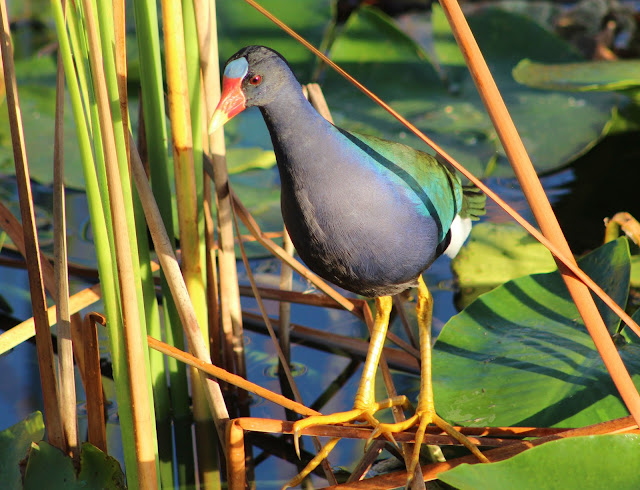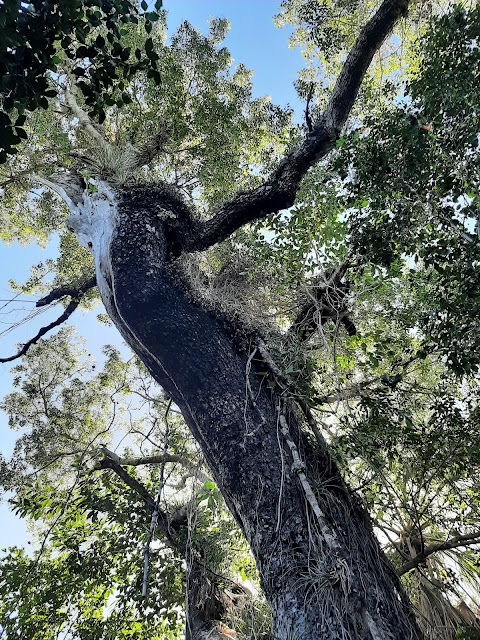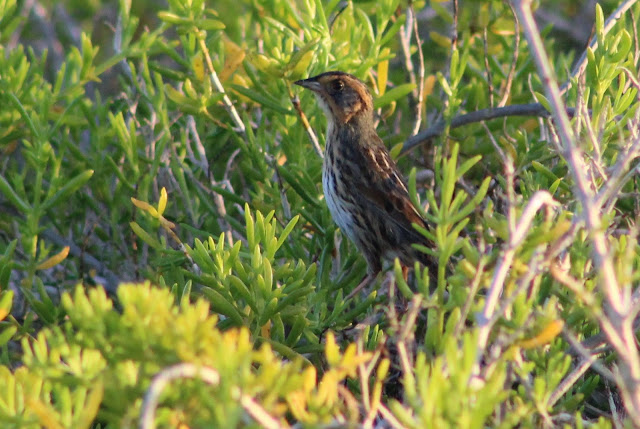When January 1st, 2022 rolled in, Caleb and I hit the road early and headed for southern Florida. Our plan while heading down was to bird Everglades National Park for a day, and the Florida Keys for another day. In this extreme southern part of Florida, we had it in mind that we could potentially find Caribbean vagrants such as Grassquits, La Sagra's Flycatcher, Key West Quail Dove, and more. There was also a shot of scarce Florida birds such as Mangrove Cuckoo and American Flamingo. White-crowned Pigeon was an expected one that both of us were expecting to get as a lifer. After a 2.5 hour drive from Sean's house, we arrived at Everglades National Park just after sunrise. It was awesome to drive into a new National Park that neither of us had been to before. In the early morning hours, the park wasn't very crowded. But as the holiday would go on, more and more would come later and crowd the place up as more than a million people visit the park annually.
The Everglades are interesting, and are a shallow and wide expanse of water moving south through sawgrass and cypress prairies. While often referred to as a "River of Grass", this river is about 50 miles wide and is only a few inches deep. The Park also has hardwood hammocks, mangrove forests, pinewoods, sawgrass and cypress prairies, lakes and ponds, and the open salt water and shoreline of Florida Bay at the southern stretches of land. What I was most impressed with were the hammocks. Florida has a lot of woodlands known as hammocks, which are isolated stands of trees that include palms, cedars, and a variety of deciduous trees. In the Everglades the hammocks consist of vegetation that is of West Indian origin with trees like Gumbo Limbo, Mahogany, Dogwood, palms, and figs. Hammocks are surrounded by more common and extensive habitats, such as pinewoods, marshes, and prairies. Birdwise, the are great for a variety of species, and we would enjoy mixed flocks of passerines the most in the hammocks and mangrove stands.
 |
Florida Panther Country!
|
Royal Palm Hammock was our first stop after we entered the Everglades. This is a popular spot for birders and tourists. When we got to the parking lot, many Black Vultures were in the parking lot hanging around. They were getting on vehicles and trying to rip things apart. Some people weren't happy with the vultures. The park even built a vulture "playground" to distract the birds from the vehicles. Aside from that, it was said to park at users risk. Trails in the area were awesome, and the first we walked was called the Anhinga Trail. A boardwalk went for about a half-mile over the marshes of Taylor Slough. A variety of birds were present and viewable, including plenty of Anhingas. I was freaking stoked at seeing them, even though I knew many more were to come. Boardwalk trails are awesome, and create great viewing. We also walked along the Gumbo Limbo Trail, which entered through the thick woodlands of the Royal Palm Hammock. While walking this trail we were in habitat that featured trees that are of West Indian Origin, (including Gumbo Limbo), which southern Florida is the only place such habitat is found in the United States. Warblers and other passerines were abundant in the woodlands, and Caleb picked up his lifer Worm-eating Warbler. Two Barred Owls called back and fourth at one point, and I was able to track them down and get obstructed visuals. At another location nearby we detected a few Pigeons being flushed higher up in trees. At the angle Caleb was at, he could see that they were our lifer White-crowned Pigeons. I saw the shape of the birds to know they were pigeons, but I hoped I would see one much better.
 |
Black Vulture playground
|
 |
Black Vulture invasion
|
 |
Male and female Anhingas
|
 |
Tricolored Heron
|
 |
Eastern Phoebe
|
 |
Black-and-white Warbler
|
 |
Female Anhinga giving me a show!
|
 |
Purple Gallinule
|
 |
Male Anhinga
|
 |
Palm trees-common perching spots for cormorants and vultures
|
 |
Gumbo Limbo Trail
|
 |
White-eyed Vireo
|
 |
Blue-headed Vireo
|
 |
Barred Owl pair
|
 |
Black-throated Green Warbler
|
 |
Great-crested Flycatcher
|
 |
Some people (non-birders) unhappy with Black Vultures
|
Later in the morning our route took us to Mahogany Hammock, which featured a neat boardwalk trail about a half-mile long. It was cool to see a Wood Stork soaring overhead. Once walking the path through the thick trees we had highlights of Short-tailed Hawk circling overhead, 2 Barred Owls calling back-and-fourth, and a variety of passerines and with good warbler numbers that included a male Hooded Warbler.
 |
Yellow-throated Warbler
|
 |
Short-tailed Hawk
|
 |
Northern Parula
|
 |
Wood Stork
|
 |
Hooded Warbler
|
 |
Short-tailed Hawk
|
 |
Barred Owl
|
After lunch, we got to see some of the views of the Florida Bay. We hiked two trails: the Coastal Prairie Trail and the Snake Bight Trail. The Coastal Prairie Trail was awesome, as we really started to hike through and along mangrove forests. We were hoping we would hear the elusive Mangrove Cuckoo, but we did see a variety of other birds. The Snake Bight Trail was a 1.8 mile hike one way as it traveled through mangrove forests and ended with a good view of Florida Bay coastline. Although American Flamingo requires luck, they have been found in the past at this view. We did get to see our first Great White Heron of the trip, which was cool. Something we also kept in mind were rarities that have been found along this trail in the past, such as Key West Quail-Dove and Western Spindalis.
 |
Anhinga or "Snake Bird"
|
 |
Great-crested Flycatcher
|
 |
Northern Parula
|
 |
Black-and-white Warbler
|
 |
Prairie Warbler
|
 |
Dense mangrove forest, can you spy Caleb in there?
|
 |
Picnicing Red-shouldered Hawks
|
 |
Wood Stork
|
 |
| Willet |
 |
Black-necked Stilt
|
 |
Great White Heron
|
 |
Tricolored Herons
|
 |
Northern Waterthrush
|
Aside from these mentioned spots, we stopped at many other spots during the day. Some of the stops were short, but we really got a taste of how fun the Everglades are. My pictures on this post will show more of the bird diversity than what I've written about.
 |
male Anhinga
|
When we went back to town after exploring the Everglades, we were originally planning on going to the Florida Keys and down as far south as Key West. Caleb felt like the Keys didn't have the best reports, and that we would have better luck in exploring Everglades National Park for a second day. And we would explore the Everglades again and skip the Florida Keys for this trip.
On January 2nd, we headed to the southern part of the park to explore the Coastal Prairie Trail. In the research Caleb did, he realized that Saltmarsh Sparrows were found in some of the grassy coastal habitats that were near the mangrove forests. We walked out to the area with Saltmarsh Sparrow habitat first, and I was impressed that it didn't take long to hear several Sharp-tailed Sparrow species start calling. One of them popped up, and dark streaks on the breast, sides, and white contrasting throat with the orange and gray on the head meant that it was a Saltmarsh Sparrow! This was a lifer for me, and a highly wanted one. It was the last regularly occurring sparrow I needed for the United States. These sparrows winter in low numbers along both Florida coasts, where they are local. They are restricted to saltmarshes along the Atlantic Coast for breeding, and they are endangered due to rapid loss of habitat.
 |
Red-bellied Woodpecker
|
 |
Saltmarsh Sparrow!!
|
 |
Saltmarsh Sparrow Everglades coastal habitat
|
After the quick success with Saltmarsh Sparrow, we went to walk the Guy Bradley Trail. This trail went along the Bay, and through Mangrove forests. An impressive diversity of 55 species of birds were present for us, including several shorebird species that were Florida firsts for us. During the morning we also realized that a Christmas Bird Count was taking place in Everglades National Park. We started to see many birders in teams of two, and we did see a few birders walking the mangrove woodlands while we were looking at Saltmarsh Sparrows. On the Guy Bradley Trail we saw two birders participating in the CBC, a man and a women. The man seemed cool, but the lady asked us if we were doing the CBC. We said no, and she seemed annoyed with us and snapped back, "Well, we can't double up and have two teams". What a perfect bitch she was. Minutes after that, Caleb flushed a White-crowned Pigeon. I was pumped, and I hung out with this bird for about 15 minutes after I got poor looks the previous day. White-crowned Pigeons are large pigeons that are wary and often shy, and will often stick to the tops of trees. This bird is a Caribbean species that is common in coastal lowlands, and especially in mangroves. It has a limited range in the United States, where extreme southern Florida is the only region where it can be found. Also, it's white crown that sharply contrasts with the rest of it's dark body means that the bird is named well. This one was truly my lifer-neat bird! We also scanned the coast for some time too which was nearby, and we added more shorebirds to our Florida lists. Many folks camped along the shoreline, and Red-shouldered Hawks utilized many perches, including tents. A Manatee also made an appearance in a boating area, a lifer mammal!
 |
White Ibis
|
 |
young Red-shouldered Hawk
|
 |
| Osprey |
 |
Prairie Warbler
|
 |
White-crowned Pigeon!
|
 |
Blue-gray Gnatcatcher
|
 |
young and adult Yellow-crowned Night Herons
|
 |
Manatee getting air
|
 |
Red-shouldered Hawk at camp
|
 |
Black and Turkey Vultures
|
The Flamingo Campground was a fun spot to bird. It had lots of interesting habitat, one that held good potential for rarities like Grassquits.
 |
White-eyed Vireo
|
 |
female Painted Bunting
|
 |
Prairie Warbler
|
 |
| Osprey |
 |
White-eyed Vireo
|
Once we reached the afternoon, we hit a variety of spots. The Long Pine Key Campground and Trail was a fun spot, and was right in midst of pinewood habitat. A Cuban Pewee was found here before. Lucky Hammock, part of a place called Frog Pond Wildlife Management Area just outside the Park, was a fun place to bird. We went there to find a Brown-crested Flycatcher, which is scarce Florida species. There even ended up being two Brown-crested Flycatchers. We closed the Everglades out at a place called L31W Canal. It featured classic Florida birds such as Wood Stork and Anhinga, and we also got to see several White-tailed Kites, which are quite scarce in Florida.
 |
Little Blue Heron
|
 |
Double-crested Cormorant
|
 |
| Anhinga |
 |
Wood Stork
|
 |
White-tailed Kite
|
 |
Turkey Vulture
|
A great way to spend the first two days of 2022, in Everglades National Park!



















































































































































